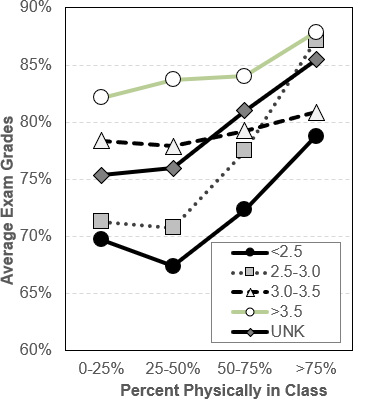A professor's experience with the 2019 polar vortex offers insight into how institutions might cope with the possible spread of the newest coronavirus.

I suspect it's inevitable that at some point, a student on my campus will be diagnosed with a highly communicable illness, be it the current coronavirus (COVID-19) or another disease. Given the academic institution's responsibility to protect students and staff, my expectation is that students with a diagnosed disease would be individually quarantined and treated medically. But if the disease was discovered in, say, a dormitory or a specific community, I imagine that more drastic steps would be taken, such as limiting campus transportation and public gatherings and possibly even shuttering classrooms. One can't help but wonder how such a situation would affect the academic mission of an institution. If the threat prevailed, would semesters be canceled? How would that impact students' ability to progress through their education? Would the institution need to refund students for their tuition? An epidemic would pose potentially massive disruptions for students, faculty, staff, and the institution.
My experience with the polar vortex may offer insight into how an institution might cope with such a scenario. On January 31, 2019, the midwestern United States experienced a period of extremely cold temperatures and winds that drove wind chills to as low as -57°F in parts of the Midwest. In response, my institution and many other academic institutions in the Midwest canceled classes for two or more days.1
I teach an introductory course titled Extreme Weather. It seemed wrong to allow such a teachable moment to pass, so I was determined to conduct class despite the classrooms being off-limits and buildings closed. The challenge was amplified by the fact that I was traveling in Washington, DC, and because the classrooms were closed, the guest lecturer I had planned for the day would not be able to help.
Fortunately, the class I teach is enabled by a technology that records the projected image and audio so that students can access the class content asynchronously, for future reflection. The system also allows me to broadcast class synchronously, creating a blended learning environment so that students who are ill or traveling or otherwise not in the classroom can participate in class exercises and discussions during class time. Students can see what's being projected, answer questions, ask questions that I or my teaching assistant will answer during or after class, and indicate when they don't understand (I call that the "WTF" button) so I can see how many students are confused as the class is going on.
The system also includes a "universal capture" option, which allows me, as the instructor, to connect from wherever I am and either record a video to share with the class asynchronously or broadcast class synchronously to all students. Being on the road, I did the latter and conducted a timely discussion about the polar vortex that was the root cause of the bitterly cold weather.
At the end of the semester, I conducted a survey with the question "Would you recommend live streaming be available in all your courses?" Of the respondents (N=196), 55 percent said "Yes, all courses," and another 32 percent said "Yes, but only all large courses." Hence 87 percent indicated that they would like a live-streaming option to be included in at least all large courses at my institution.
Now I'm guessing that my instructional colleagues would recoil at the concept of broadcasting their classes remotely in the absence of emergency conditions. They would argue that the percentage of students who opt to attend class in person would decrease significantly with this option. And in my experience, they would be correct. Over the multiple semesters I've used this system in my course, the number of students who physically come to class has decreased to about 33 percent of the total by the end of the semester. But my attitude is that if a student can do well on homework and exams without physically coming to class, why should I care? It's true that with fewer students, the in-class discussions can be less fruitful and also that when I tell a joke, the chances of getting a chuckle diminish (though the odds were poor to start with). On the other hand, with the availability of the streaming option, overall class attendance (measured by the number of students who answer questions during class) has averaged over 85 percent every day.
But there are also reasons to be concerned about the efficacy of remote synchronous class delivery. I have extracted system data about student behaviors (e.g., participation as measured by number of questions asked, number of slides viewed, and number of notes taken), and the data indicates that the students who attended class in person more than 75 percent of days scored an average 7 percent higher on exams than those who attended class in person less than 50 percent of days.2 The data on behaviors also shows that students who attend class remotely take fewer notes, view fewer slides, and participate in fewer classroom activities than those who attend class in person.
Remote attendance may also affect different cohorts of students differently. In my research, students whose incoming grade point average (GPA) was less than 2.5 were far more likely to participate remotely than those with higher incoming GPAs. Using the data from the system, I created graphs (e.g., see figure 1) that demonstrate the impact of physically attending class stratified by students' incoming GPA. I've started displaying these results to provide evidence that might motivate students' behaviors.

My experience with the polar vortex has taught me that instruction can go on, regardless of what the world throws at us. Technology allows instructors to continue with classes and have live, interactive discussions. But if it becomes necessary to use remote synchronous class delivery, instructors should monitor how this mode of delivery impacts students, especially in the areas of participation and exam scores. Technologies that support remote synchronous learning must incorporate strategies (e.g., requiring that students answer questions during class or lose credit) to encourage attentiveness and participation in the absence of physical presence.
For more insights about advancing teaching and learning through IT innovation, please visit the EDUCAUSE Review Transforming Higher Ed blog as well as the EDUCAUSE Learning Initiative and Student Success web pages.
The Transforming Higher Ed blog editors welcome submissions. Please contact us at [email protected].
Notes
- Michael James, "Icy Cold of the Vortex Lays Waste to Plans, Closing City Halls, Schools, Zoos across US," USA Today, January 28, 2019; Martin Slagter, "University of Michigan Cancels Classes for 2 Days with -45 Wind Chill Expected," MLive, January 29, 2019. ↩
- Perry Samson, "Differences in Engagement and Performance between Synchronous Face-to-Face and On-Line Students," Journal of Geoscience Education, in press. ↩
Perry J. Samson is a Professor in the Department of Climate and Space Sciences and Engineering at the University of Michigan. He blogs at Sage on Stage.
© 2020 Perry J. Samson. The text of this work is licensed under a Creative Commons BY-NC-SA 4.0 International License.
